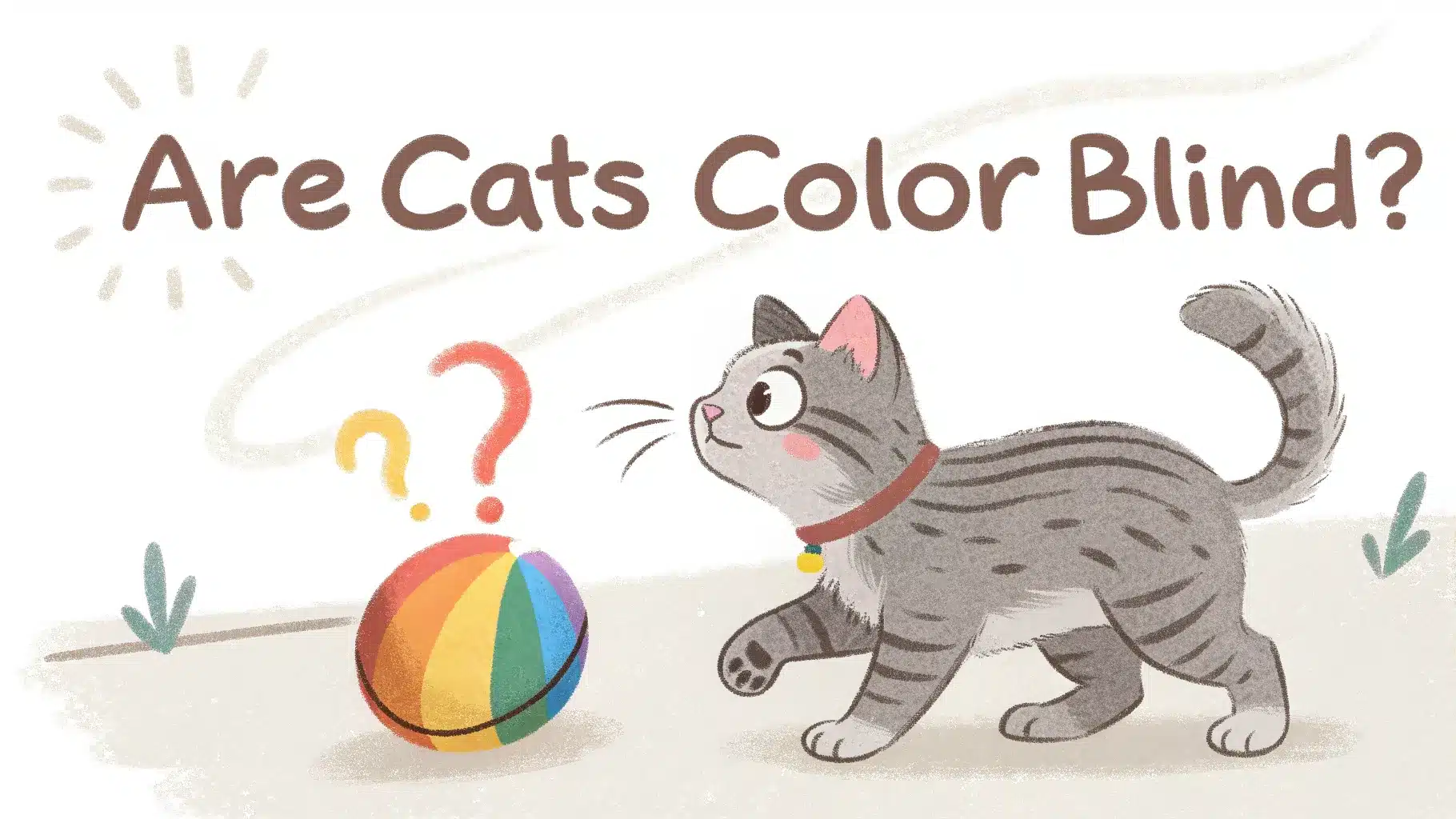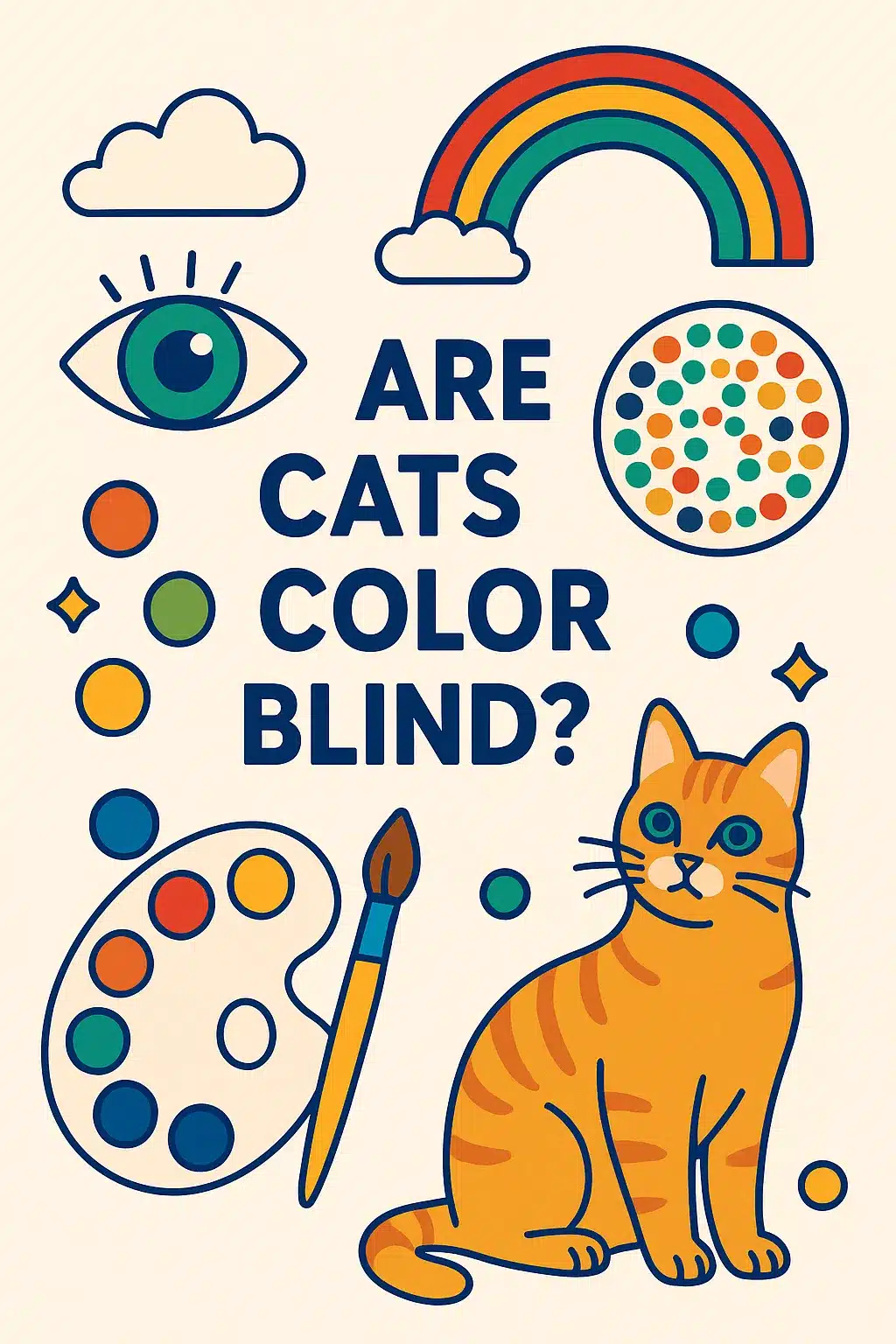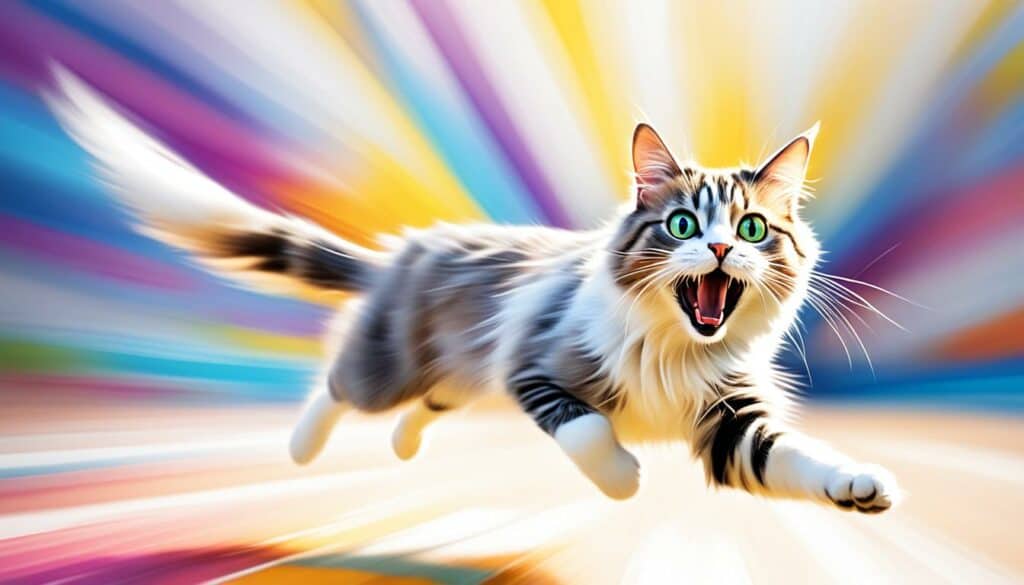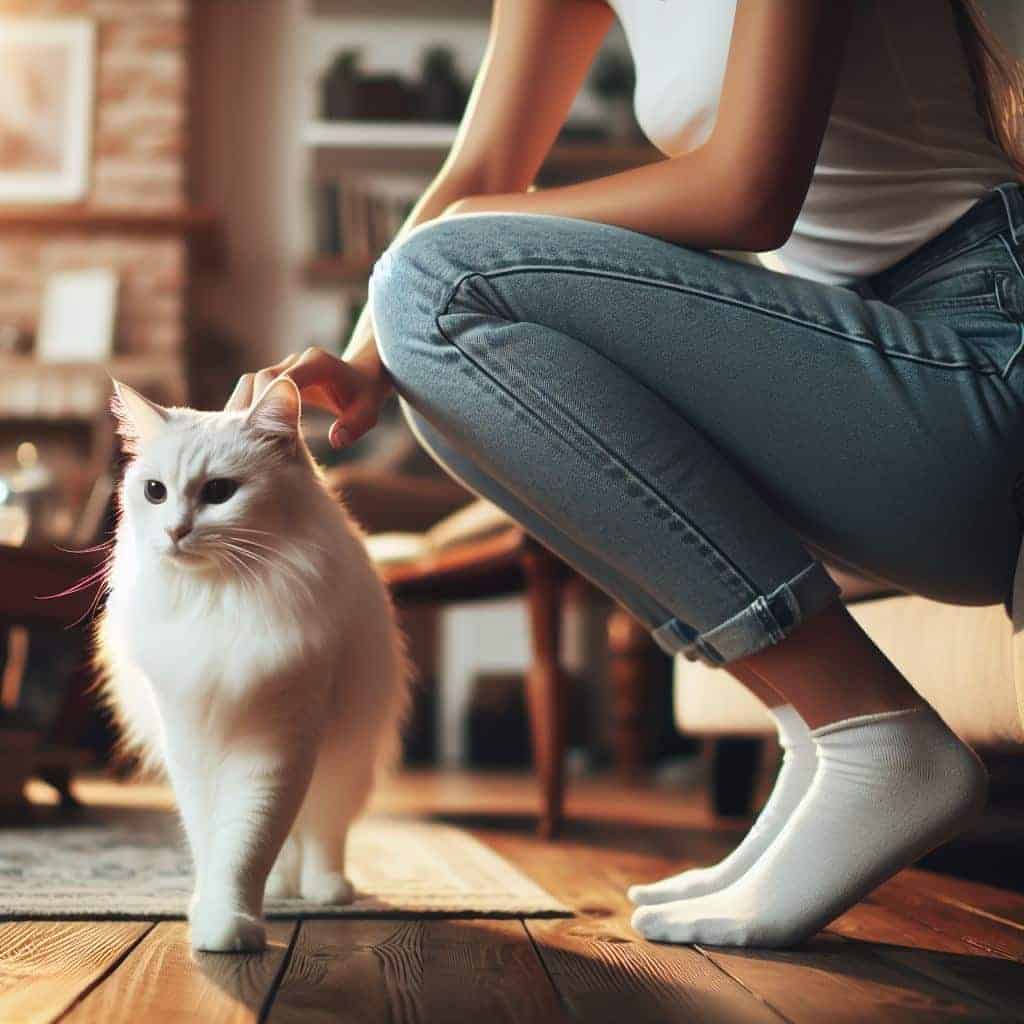
Cats see the world differently than you do. While humans enjoy a vibrant spectrum of colors, cats experience a more muted palette. They primarily perceive blues and greens, struggling with reds and pinks. This unique vision stems from their eye structure, prioritizing movement detection over color distinction. Moreover, cats have fewer cone cells, which limits their color perception. However, they excel in low-light conditions due to a higher number of rod cells. This adaptation makes them exceptional hunters, able to spot even the slightest motion in dim environments.
So, are cats color blind? Not entirely, but their vision is certainly distinct from ours.
1. Cone Cells
Structure of Cat Eyes
When you look into a cat’s eyes, you’re seeing a marvel of nature. Cats have a unique eye structure that sets them apart from humans. Their eyes contain fewer cone cells, which are responsible for color vision. This means cats don’t see the world in the same vibrant colors that you do.
Instead, they perceive a more limited palette.
Cats’ eyes are designed for a different purpose. They excel in low-light conditions, thanks to a higher number of rod cells. These cells are sensitive to light and motion, making cats exceptional hunters, especially at dawn and dusk. The structure of their eyes prioritizes detecting movement over distinguishing colors. This adaptation helps them survive in the wild, where spotting prey is more important than identifying its color.
Types of Cones in Cats
Cats have two types of cone cells, unlike humans who have three. This difference limits their ability to perceive the full spectrum of colors. Cats primarily see shades of blue and green. They struggle with reds and pinks, which appear more like grays or browns to them.
Here’s a simple comparison of cone cells in cats and humans:
|
Feature |
Cats |
Humans |
|---|---|---|
|
Number of Cone Types |
2 |
3 |
|
Primary Colors Seen |
Blue, Green |
Red, Green, Blue |
|
Color Perception |
Limited |
Full Spectrum |
|
Low-Light Vision |
Excellent |
Moderate |
Scientific Research Findings:
-
Exploring Cat Color Perception: Cats perceive the world in shades of blue, green, and yellow due to their limited color vision.
-
Cat Vision and Color Perception: Cats have fewer cones in their eyes compared to humans, limiting their color perception to shades of blue and yellow.
Understanding these differences helps you appreciate how cats interact with their environment. Their vision is tailored to their needs as predators, focusing on movement and low-light visibility rather than a wide range of colors.
2. Blue and Green Sensitivity
Sensitivity to Specific Wavelengths
Cats have a unique way of seeing the world, and it all comes down to their sensitivity to specific wavelengths of light. Unlike humans, who have three types of cone cells in their eyes, cats only have two. This difference means that cats are particularly sensitive to blue and yellow light. They can see shades of these colors more clearly than others.
When you think about how cats perceive colors, imagine a world where blues and greens stand out, while reds and pinks fade into the background. Cats’ eyes are not equipped to detect the full spectrum of colors that humans can. Their cones are most responsive to shorter wavelengths, corresponding to blue and green hues. This limited color perception shapes how they interact with their environment.
Visual Experience of Cats
Imagine seeing the world through a cat’s eyes. You’d notice that their visual experience is quite different from yours. Cats perceive a more muted palette, where blues and greens are prominent, but reds and pinks are almost invisible. This unique vision affects how they navigate their surroundings and interact with objects. Cats rely heavily on their ability to detect movement and contrast rather than color. This adaptation is crucial for their survival as predators.
In low-light conditions, their vision excels, allowing them to spot prey even when colors are indistinct.
The world through a cat’s eyes is one of subtle contrasts and movements, rather than vibrant colors. Understanding this aspect of cat vision can help you appreciate why your feline friend might prefer certain toys or react differently to various stimuli.
Their world is shaped by shades of blue and green, and their behavior reflects this fascinating perspective.
3. Behavioral Studies
Experiments on Color Distinction
You might wonder how scientists figured out that cats see colors differently. Researchers have conducted various experiments to understand this. They often use color-based tests to see how cats react to different hues.
In these experiments, cats are presented with objects of various colors to observe their ability to distinguish between them.
For example, a study might involve placing two bowls of food in front of a cat, each marked with a different color. The goal is to see if the cat can consistently choose the bowl with a specific color. These tests reveal that cats struggle to differentiate between reds and greens. They tend to perform better when distinguishing blues and yellows. This aligns with the understanding that cats primarily see in shades of blue and yellow.
These findings help debunk myths about cat vision. They provide a more accurate picture of how cats perceive their environment. Understanding these nuances allows you to appreciate the unique way cats interact with the world.
Implications for Cat Behavior
So, what does this mean for your feline friend? Knowing that cats see colors differently can explain some of their behaviors. For instance, you might notice that your cat prefers certain toys over others. This preference often relates to the colors they can see best.
Toys in shades of blue or yellow might catch their attention more than those in red or pink.
Cats rely heavily on movement and contrast rather than color. This reliance makes them excellent hunters. They can spot prey even when colors are indistinct. Their vision is tailored to detect motion, which is crucial for survival in the wild. Understanding these aspects of cat vision helps you choose toys and activities that align with their sensory experiences. It also sheds light on why they might react differently to various stimuli.
So, are cats color blind? Not entirely, but their unique vision shapes their behavior in fascinating ways.
4. Toy Preference
Anecdotal Observations
You might have noticed that your cat shows a preference for certain toys. Many cat owners observe that their feline friends gravitate towards toys in shades of blue and yellow. This isn’t just a coincidence. Cats’ eyes are most sensitive to these colors, making them more visible and enticing.
Imagine your cat’s excitement when it spots a bright blue ball rolling across the floor. This color stands out in their limited visual spectrum, capturing their attention more effectively than reds or pinks. This observation aligns with their natural hunting instincts. Cats often favor toys that mimic prey, not just in movement but also in appearance.
Toys with contrasting colors or patterns can stimulate their predatory behavior, making playtime more engaging. By choosing toys in colors that cats can see best, you enhance their play experience and keep them entertained.
Visual Stimulation and Play
Understanding your cat’s color vision can transform playtime into a more stimulating experience. Cats are naturally drawn to movement, but the right colors can amplify their interest. Toys that feature blue and yellow hues are not only more visible but also more exciting for your cat.
These colors stand out against the background, making it easier for your cat to track and pounce.
Consider this when selecting toys:
-
Color Visibility: Choose toys in blue and yellow for maximum visibility.
-
Movement: Opt for toys that move or mimic prey to engage your cat’s hunting instincts.
-
Contrast: Look for toys with contrasting patterns to catch your cat’s eye.
Here’s a quick comparison of toy features that appeal to cats:
|
Feature |
Description |
Benefit to Cats |
|---|---|---|
|
Color |
Blue and Yellow |
High visibility in cats’ color range |
|
Movement |
Mimics prey |
Engages hunting instincts |
|
Contrast |
Bold patterns |
Enhances visual stimulation |
|
Interactivity |
Requires cat’s participation |
Encourages active play |
Once you understand these preferences, you can create a more enjoyable and enriching environment for your cat. Picking toys that align with their visual capabilities not only keeps them entertained but also supports their natural behaviors.
5. Hunting Behavior
Visual Cues in Hunting
When your cat is on the prowl, its vision plays a crucial role. Cats rely heavily on visual cues to detect and track their prey. Their eyes are finely tuned to pick up on movement, which is essential for successful hunting. Cats can spot even the slightest twitch of a mouse’s whisker or the flutter of a bird’s wing. This ability stems from their eye structure, which prioritizes motion detection over color distinction.
Cats’ limited color vision doesn’t hinder their hunting prowess. Instead, it enhances their focus on movement and contrast. They excel in low-light conditions, where their prey might feel safe. This adaptation allows them to hunt effectively at dawn and dusk, times when many other animals struggle to see clearly.
Recognize these visual cues and you can better understand your cat’s hunting behavior. Whether it’s stalking a toy or pouncing on a shadow, your cat’s actions are guided by its unique vision.

Interaction with Prey
Your cat’s interaction with prey is a dance of instinct and skill. Cats use their keen eyesight to gauge distance and timing, ensuring a precise strike. Their eyes lock onto the target, tracking its every move. This intense focus is a testament to their predatory nature. Cats often rely on their ability to detect subtle contrasts and movements rather than vibrant colors. This focus helps them differentiate between a still object and a living creature.
When a cat spots its prey, it crouches low, minimizing its silhouette. It waits for the perfect moment to pounce, using its powerful hind legs to launch itself forward.
Understanding these interactions can enhance your appreciation for your cat’s natural instincts. Provide toys that mimic prey behavior and you can engage your cat’s hunting instincts in a safe and stimulating way. Consider toys that move unpredictably or make sounds, as these features can mimic the experience of real prey.
Here’s a quick comparison of how cats interact with prey versus toys:
|
Feature |
Real Prey Interaction |
Toy Interaction |
|---|---|---|
|
Movement |
Unpredictable and erratic |
Can be controlled or automated |
|
Sound |
Natural sounds like rustling or chirping |
Built-in sounds or squeakers |
|
Visual Cues |
Subtle contrasts and movements |
Bright colors and patterns |
|
Engagement |
High due to survival instincts |
Varies based on toy design |
Understand your cat’s hunting behavior and you can create an environment that satisfies its natural instincts. This knowledge not only enriches your cat’s life but also strengthens the bond between you and your feline friend.
You’ve explored how cats perceive the world with their unique vision. Unlike humans, cats see a limited color spectrum due to fewer color receptors in their eyes. They primarily detect blues and greens, which aligns with their evolutionary adaptation for hunting in low light. This doesn’t mean cats are completely color blind, but their vision is indeed more restricted compared to ours. Understanding these differences helps you appreciate your cat’s behavior and preferences.

In her previous life, Lisa traveled extensively, both for work and leisure. After the pandemic struck, Lisa locked up her luggage and adopted a cat ever since.
Lisa is now an avid cat lover, she devotes most of her free time serving as butler to her adorable feline at home. When she is not with her cat, she can be seen using her phone sourcing for the latest cat supplies online.


